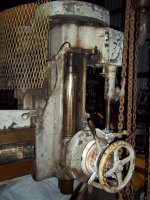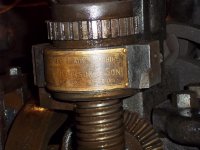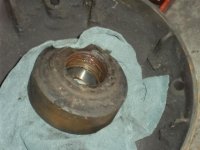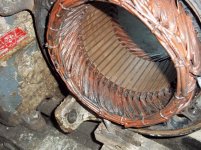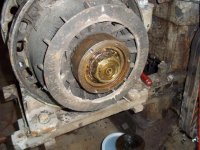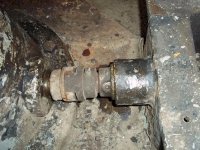handsome devil
Hot Rolled
- Joined
- May 4, 2005
- Location
- Bonduel, Wi
Hi all. Ended up selling Excessior camelback drill press to make room for another large drill I don't need. Pretty much inherited this radial drill press. It had been reworked many years ago and then spent almost 15 years outside under a tarp. Surprisingly it is not in bad shape the last owner tried to keep it from serious decay. After moving to Oregon from Wi he had to move it or we had to move it. He was gone. So it was sitting outside a trucking company warehouse with a not very stable future. Its future may not be real stable now, but it won't be scrapped and is now under my roof. It is fairly heavy and was a bugger for me to move. My gantry crane handled the unloading ok but I managed to be stupid and broke a gear on top the column. I am pretty sure I can repair it. Had an offer to have a new one made by a friend but think the repair will be good enough. I did not have enough height and the chain from my hoist caught the gear and it was over very quickly. Guess this thing weighs about #8000. Once I got it turned sideways on my trailer then I was able to lower using two hoists at the same time. My 6 ton did most the work and my smaller one helped level and keep things level. I am very pissed at myself for breaking the gear though. That could of been avoided. I was nervous about how this lift was going to go and wasn't thinking clearly enough to avoid the stupid. Now I can spend my time fixing my mistake. Good news after a 175 mile trip it was the only fly in the ointment. No more damage and no deaths or injuries. I ran a smaller one many years ago and think it an awesome machine. Now I need to find something that needs drilling. I have drills up to 2.5" or so. Just no work for it.
Not sure who built this. No tags other than Ryerson Machinery, Chicago, Ill and Joseph T Ryerson cast into the base of the column. Guess the build date to be in the 1920s? Will try and post pictures here but most of them were indoors and are not the greatest. Should of taken pictures with it on my trailer, now it is off to the side so I can get small machinery in and out of my shop this winter. Will be changing oil outside I guess.
From my searches I find Ryerson Machinery, Chicago Ill was a dealer not a mfg? But no other ID and his name Joseph T Ryerson is cast into the base. So not sure who the exact builder was? Any ideas? The drive is a GE 5 hp induction motor with a Drive-All gear box on top of a heavy duty base. This to me does not appear to be factory original but has been in place for a very long time and the GE motor is an oldie.
I have a fairly large Cincinnati camel back that is going to be leaving shortly also to make room. I hate to part with this but even I can't believe I will get around to rewiring it and use it when this thing is in the shop collecting dust too. I need the room. I may post pictures if I learn how too, and offer it here before I take it to auction. Think it is a #4 Morse taper. While I could keep both I won't. I have to be strong and let something go. Last minute update. I took me litterly hours to post these two lousy pictures. There has to be an easier way to post than I am doing. I could not find a up to date post on how to do pictures. Used to use photo bucket but now I am back on my own with posting pictures. Regards, John.View attachment 213347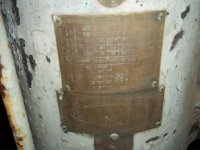

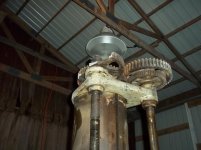

Not sure who built this. No tags other than Ryerson Machinery, Chicago, Ill and Joseph T Ryerson cast into the base of the column. Guess the build date to be in the 1920s? Will try and post pictures here but most of them were indoors and are not the greatest. Should of taken pictures with it on my trailer, now it is off to the side so I can get small machinery in and out of my shop this winter. Will be changing oil outside I guess.
From my searches I find Ryerson Machinery, Chicago Ill was a dealer not a mfg? But no other ID and his name Joseph T Ryerson is cast into the base. So not sure who the exact builder was? Any ideas? The drive is a GE 5 hp induction motor with a Drive-All gear box on top of a heavy duty base. This to me does not appear to be factory original but has been in place for a very long time and the GE motor is an oldie.
I have a fairly large Cincinnati camel back that is going to be leaving shortly also to make room. I hate to part with this but even I can't believe I will get around to rewiring it and use it when this thing is in the shop collecting dust too. I need the room. I may post pictures if I learn how too, and offer it here before I take it to auction. Think it is a #4 Morse taper. While I could keep both I won't. I have to be strong and let something go. Last minute update. I took me litterly hours to post these two lousy pictures. There has to be an easier way to post than I am doing. I could not find a up to date post on how to do pictures. Used to use photo bucket but now I am back on my own with posting pictures. Regards, John.View attachment 213347




Last edited:




